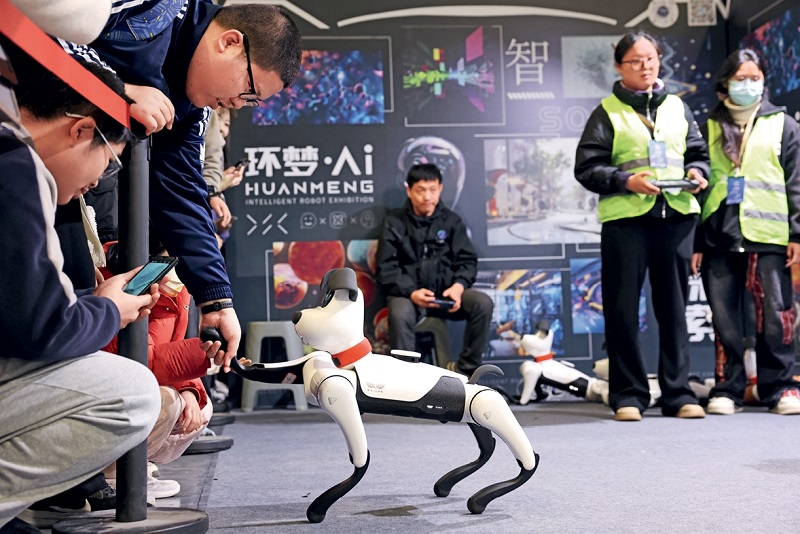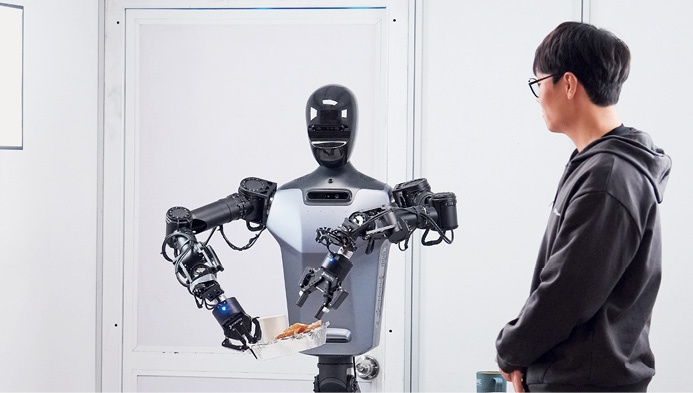
A display of robotic exoskeleton equipment at the 7th China International Import Expo in Shanghai, on November 6, 2024.
The era of embodied intelligence robots – robots with embodied artificial intelligence, which enables them to perceive, learn from, and dynamically interact with their environment – is not only about breakthroughs in hardware performance, but about the exploration and development of practical applications.
“When drones first appeared, people did not know how to use them,” said Zhang Yueming, chief scientist at Beijing Chietom Precision Transmission Technology Co., a Beijing-based maker of high-precision gear reducers used in industrial robot joints. “Then they gradually found their application scenarios. It will be the same with embodied intelligence robots.”
Man’s New Best Friend
Both enterprises and government departments are striving for ways to use the new-generation robots and factories are one of the targets for their commercial use. The use of embodied intelligence robots in factories is gradually increasing, especially in high-risk extreme scenarios, replacing humans in specialized operations. Particularly in harsh and dangerous environments such as nuclear waste management, oil and gas pipeline inspections, firefighting, and mine inspections, companies expect to enhance human work efficiency and reduce casualties through these robots which can be remote-controlled and have intelligent decision-making abilities.
Currently, a number of specialized robots are deployed in practical scenarios, such as power distribution rooms – rooms or areas in a building where transformers and high-voltage switchgear are kept, chemical deflagration drills, and railway stations. However, when it comes to embodied intelligence robots or humanoid robots, both domestic and international companies are still in the early stages of developing them, according to Gao Chao, vice president of CCID Consulting Advanced Manufacturing Research Center.
Zhang echoed him, saying, “Embodied intelligence robots are still in the developmental stage.”
Currently, most of the purchase orders for embodied intelligence robots in China come from the education sector. A report by Haitong Securities in November 2024 indicated that the largest application areas for quadruped robots are education and entertainment, followed by scientific research. Mainly research institutions and schools are ordering humanoid robots for research and teaching purposes.
In addition, organizations from the exhibition, advertising, and culture industries lease these robots primarily to use them at exhibitions, showcasing their interactive capabilities and utilizing their unique appearance and technical characteristics. They are also used in new marketing methods.
UBTECH Robotics’ humanoid robot Walker has powerful vision capabilities to detect and recognize faces, objects and scenes in complex background environments. It also has strong balance, adapting to different terrains, and can be used on factory assembly lines. It is already being used in multiple technology exhibition halls, having completed over 3,000 regular appearances. The third-generation Walker X provided guided reception services at the China Pavilion during Expo 2020 Dubai for six months.

A robot dog performance at an AI exhibition in Fuzhou, Fujian Province, on March 8, 2025.
Robots as Caregivers
However, currently, factories, logistics, and the education sector have only limited opportunities to use such hi-tech robots. They are mostly a few scene-specific and, relatively unsophisticated fixed tasks.
The larger market is the home, particularly rehabilitation and elderly care.
According to data from the National Health Commission, the population aged 60 and above in China is expected to exceed 400 million around 2035. Facing a shortage of caregivers and an increasingly aging population, embodied intelligence robots can meet the demand for elderly care to some extent.
However, industry insiders generally believe that it will take at least 10 years for embodied intelligence robots to be applied at home. According to Gao, the requirements in these fields are very high, the home environment is more complex and changeable, and the tasks are complex and mixed.
1X Technologies, a U.S.-Norwegian AI robotics company, is a leader in humanoid robotics, developing general-purpose robots designed to live among humans in the home and learn from them. The robots can perform basic household tasks such as folding clothes, organizing items, making coffee, doing laundry, and vacuuming, although their movements are relatively slow. In China, Shanghai-based robot company Fourier is making robots equipped with dexterity and intelligence for medical rehabilitation, scientific research and other common uses. It already provides robotic services to hospitals around the globe and is expected to develop robots for household work, elderly care and education in the future.
According to Gao, to use domestic robots, the safety and usability threshold has to be very high as these robots will live with people day and night, and the users will not be professional operators. So there will be considerable concerns about how safe they are. Accepting them and using them is something that has to be cultivated gradually.

A humanoid robot picks up leftover food from a table at the Beijing Humanoid Robot Innovation Center on March 12, 2025.
The Price Factor
“Moreover, users are also very price-sensitive. To enter thousands of households, the product prices have to be reduced through scale effect,” Gao said.
Currently, the pre-sell price of Unitree Robotics’ H1 humanoid robot is RMB 650,000. The functionality and price have not yet reached the level of widespread household adoption.
Gao says policies have a significant role to play here. The government needs to encourage organizations to open up more high-end application scenarios. It should increase financial and tax support, especially increase support for research and development, and coordinate the construction of public platforms such as intelligent robot computing power centers and testing and inspection centers to create more resources for the healthy and rapid development of the industry.
In October 2024, the Beijing Humanoid Robot Innovation Center was jointly inaugurated by the Ministry of Industry and Information Technology (MIIT) and the Beijing municipal government for research and development of key common technologies in the industry.
Embodied intelligence robots are sparking a new round of venture capital investment globally, with top technology companies from various countries eager to participate.
According to the Humanoid 100: Mapping the Humanoid Robot Value Chain, a global top 100 list of companies in the humanoid robotics sector released by Morgan Stanley in February, 52 companies are currently involved in developing humanoids.
NVIDIA, OpenAI, Microsoft, Google, and other U.S. technology giants are investing in embodied intelligence. In China, Chinese humanoid robot companies gained 74 financings in 2024, completing 10 transactions in January 2025.
China in Global Competition
In terms of patent applications, China ranks first worldwide. In the past five years, the number of patent applications mentioning humanoid robots was 5,688. In the U.S. it was just 1,483.
According to Gao, the current hardware performance and mobility capabilities of humanoid robots are basically comparable both domestically and internationally. Unitree’s quadruped robot dog can perform difficult actions such as rolling and jumping, and its humanoid robot can dance.
The research report from Haitong Securities last November showed that the U.S. has made more progress in the commercialization of embodied intelligence robots. Before they entered automobile factories, a significant number was used in the logistics and transportation sector, transforming the traditional transportation model and achieving mass commercial delivery.
After acquiring robotics company Kiva Systems in 2012, Amazon began exploring the application of robots and intelligent technologies in its warehouses and for logistics. It now employs over 750,000 robots, making it one of the largest users of robots in the world.
In 2023, Digit, a humanoid robot developed by Agility Robotics, a company spun out of Oregon State University in the U.S., collaborated with GXO Logistics to undertake tasks such as handling parcels, climbing stairs, and traversing complex terrains with parcels, helping to reduce the handover time from warehouse to truck by 50 percent. As of August 2024, Digit had completed 10,000 orders, and its commercial value was preliminarily validated.

A robot baby at the Global Developers Conference in Shanghai on February 21, 2025.
The Most Urgent Task
“Many new technologies are emerging primarily in the U.S. How we can avoid being left behind, catch up, or even surpass them is currently the most urgent task,” Zhang Yueming said.
“The foreign humanoid robot products are relatively advanced in terms of operational capabilities, but we are accelerating to catch up,” Gao added.
In 2023, the MIIT issued a guideline to promote innovative development of humanoid robots. A group of embodied intelligence startups has rapidly emerged domestically. Most of these have founders with a strong technical background and they are attempting to develop smarter and more versatile robots.
According to Nicholas Wright, a neuroscientist affiliated with the Center for Strategic and International Studies, a U.S. think tank, China and the U.S. both have their advantages in developing the humanoid robot industry. China’s greatest advantage lies in large-scale manufacturing, while the U.S. advantage is the cutting-edge technology possessed by Silicon Valley giants like NVIDIA, startups, and universities.
The situation could change in the long term. Morgan Stanley anticipates that by 2050, China’s humanoid robot market will reach RMB 6 trillion, while the U.S. market will amount to US $1 trillion. 
LI SHIMENG is a reporter with China Report.